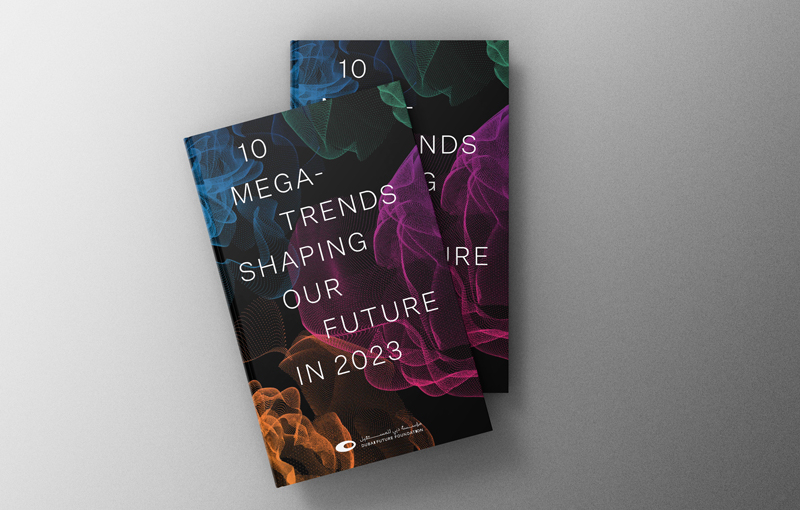Dubai Future Foundation (DFF) has published a report that identifies 10 major trends that will transform economic sectors and societies over the coming year.
The report, titled ‘10 Mega Trends Shaping Our Future in 2023‘, is part of a series of forward looking reports published by DFF. Its latest report highlights various global trends and informs decision-makers and society about current and future challenges in various sectors.
The report addresses key trends related to economies and societies, with a focus on promoting growth, prosperity and wellbeing. The trends were identified based on their degree of their significance, complexity, and relevance.

Khalfan Belhoul, CEO of Dubai Future Foundation said: “The rapid pace of technological development we are witnessing today paves the way for new and promising opportunities tomorrow. This development can be leveraged to design a better future and drive positive changes across various governmental, economic, environmental, and social sectors. Our new report encourages governments to develop proactive solutions to overcome current challenges by deploying foresight.
“The UAE has a unique, pioneering vision that seeks to turn challenges into promising opportunities. Our focus has always been on studying new trends and proactively finding the best solutions to overcome our shared challenges. Our work brings people together behind a common goal to design, test and develop inclusive solutions for all cities and communities.”
Belhoul added: “Designing the future requires a clear vision and comprehensive knowledge of the trends cities and societies are likely to encounter. The continuous development and radical change we witness daily requires us to think carefully about the future we aspire to, and work towards potential future scenarios based on evidence and accurate data. If we understand these trends, we will be able to realize new opportunities, and deploy new tools, skills and capabilities across various economic, environmental and social spheres.”
Materials Revolution
The 10 Mega Trends Shaping Our Future in 2023 report anticipates that the world will witness an acceleration in the transition from traditional resources to the use of the materials of the future. The latest digital technologies will be used to create materials with highly specific properties, similar to properties found in natural materials. These new materials may well represent the new frontier for the Fifth Industrial Revolution.
New materials and industrial inputs will meet our future needs. They could include sustainable substances for consumer products, smart construction materials, synthetic fuels, environmentally friendly batteries, and advances in semiconductors to achieve more efficiency in solar cell design.
Devaluation of Raw Data
The proliferation of data will reach the limits of practical application. The process will also be limited by the introduction of data privacy regulations. Opportunities will lie in new and better use of available data applied to emerging business models. The digital trade of goods and services represents the next frontier of profitable data use enhanced by greater sharing of aggregate data across industries and countries, generating greater economic returns.
Technological Vulnerabilities
The third global trend in the report highlights the need to strengthen the digital security system and technological infrastructure considering the increased number of people and machines connected to the Internet. A Cisco report anticipates that by 2023, there will be 5.3 billion Internet users (two-thirds of the global population) with 3.6 global devices per capita.
According to Fortune Business Insights, the global cyber insurance market is expected to expand at a CAGR of 25.7% by 2029 when it will reach $63.62 billion. Between 2020 and 2022, ransomware and extortion operations more than doubled, reported Accenture.
Energy Boundaries
The International Energy Agency stated that the world’s investment in energy is set to rise further after its value in 2022 reached $2.4 trillion. Carbon-based energy will remain an important element in the energy mix but growth in investments is likely to be driven almost entirely by renewables and decarbonization technologies.
The International Energy Agency also showed that Solar PV is forecast to account for 60% of the global renewable capacity and utility-scale projects account for almost two-thirds of overall PV expansion in 2022.
Saving Ecosystems
The report also suggests that environmental, social and governance (ESG) audits will continue to become increasingly important. Investors, regulators and rating agencies are requiring large corporations to play their part in sustainability. Europe has led historically, but Asian and American markets are catching up. Companies are working not just to reduce their carbon footprint, but to become net-positive.
Borderless World – Fluid Economies
The Covid pandemic has accelerated an ongoing trend where super-apps are managing trade, money transfers and jobs. That trend is likely to accelerate and draw millions into the gig economy, operating across borders.
Around the world, peer-to-peer, access-driven businesses models are emerging. Consumers are showing an increasing appetite for borrowing goods, renting homes, or offering micro-skills in exchange for access or money. According to a case study, titled “Gig Economy- The economic backbone of the future?”, the global gig economy is projected to grow by almost a third to $455 billion in 2023.
Digital Realities – immersive Virtual and Digital Spaces
The seventh megatrend is within the metaverse, gaming, and online social interactions, which will become more realistic. Gaming has become one of the key economic sectors globally. Current metaverse investments amount to hundreds of billions, and that’s just the beginning. These markets will continue to grow as games and online social interactions become more realistic and tied to product offerings in the virtual world.
Living with Autonomous Robots
The report anticipates that increased competition and a reduction in costs will boost robot production and support the integration of machines into economic sectors. Leading the charge are small and medium-sized enterprises. According to statistics from Global Brain Computer Interface, the adoption of robotics in the manufacturing sector accelerated during the pandemic. It is expected to exceed $94 billion by 2028. The global average industrial robot density on the factory floor reached an all-time high of 126 robots per 10,000 employees in 2021, compared with 66 robots in 2015. There are 3.5 million industrial robots already in operation, according to an article by Kearney.
Future Humanity
The report emphasized that human quality of life is the most important motivation for governments to develop education and mitigate challenges by offering jobs and enhancing mental and physical health. Populations are struggling with education, health, social engagements, and population growth. There are solutions to the shared challenges but strategies need redeveloping and collaborations need facilitating to open opportunities for sustainable social development.
Investments in mental health research are not commensurate with its impact. According to report by World Health Organization on mental health, only about $3.7 billion a year is spent on mental health research worldwide. More than half 56% of all mental health funding goes on basic research rather than clinical or applied research.
Advanced Health and Nutrition
The report stressed that water and food security, along with healthcare will remain common motives for strengthening global collaboration and deploying technology to support societies. Investing $18 billion a year across all low-and middle-income countries could generate economic benefits of $2.7 trillion by 2030, according to World Health Organization.
According to data by Healthcare Radius, global healthcare spending – both public and private – is estimated to rise at a CAGR of 3.9% between 2020–2024, reaching a value of $10 trillion by 2024. But one in three people worldwide still lacks access to safe drinking water, and 3 billion people do not have hand-washing facilities according to the World Economic Forum. In 2022, 50 million people in 45 countries are on the edge of starvation and $24.5 billion is needed to reach 153 million people, according to World Food Programme.
To access the 10 Mega Trends Shaping Our Future in 2023 in Arabic and English, please visit: (www.dubaifuture.ae/megatrends).
